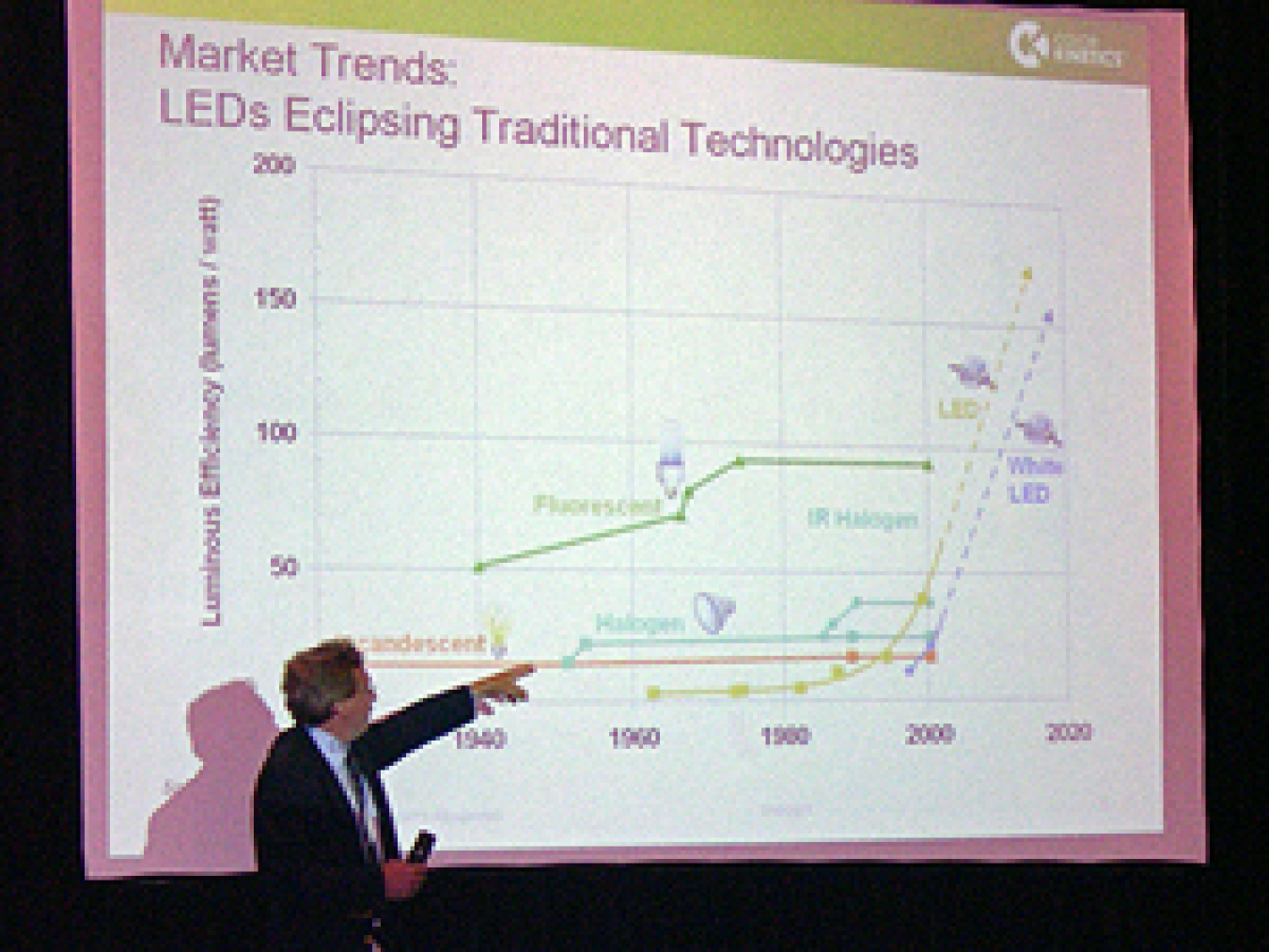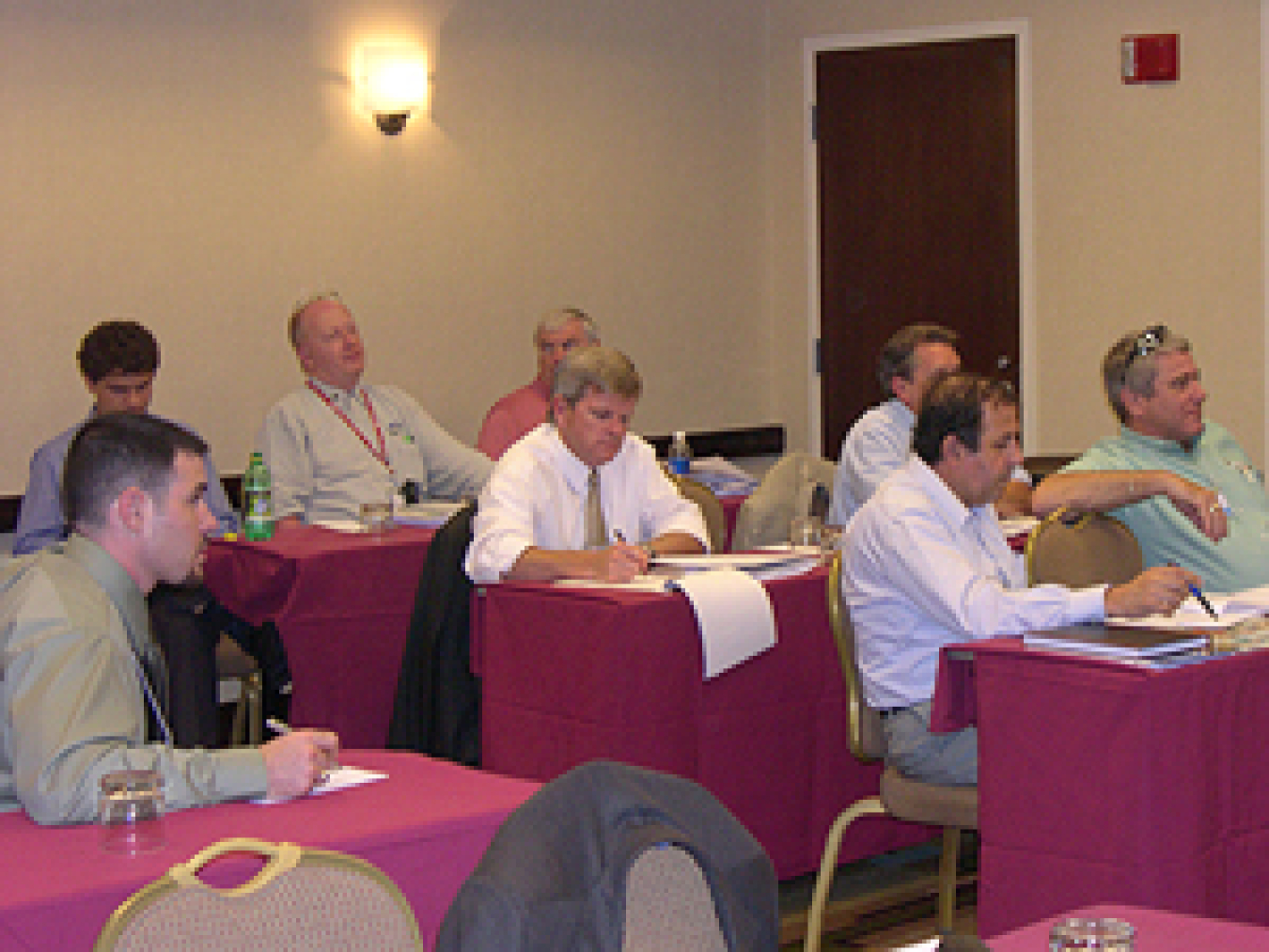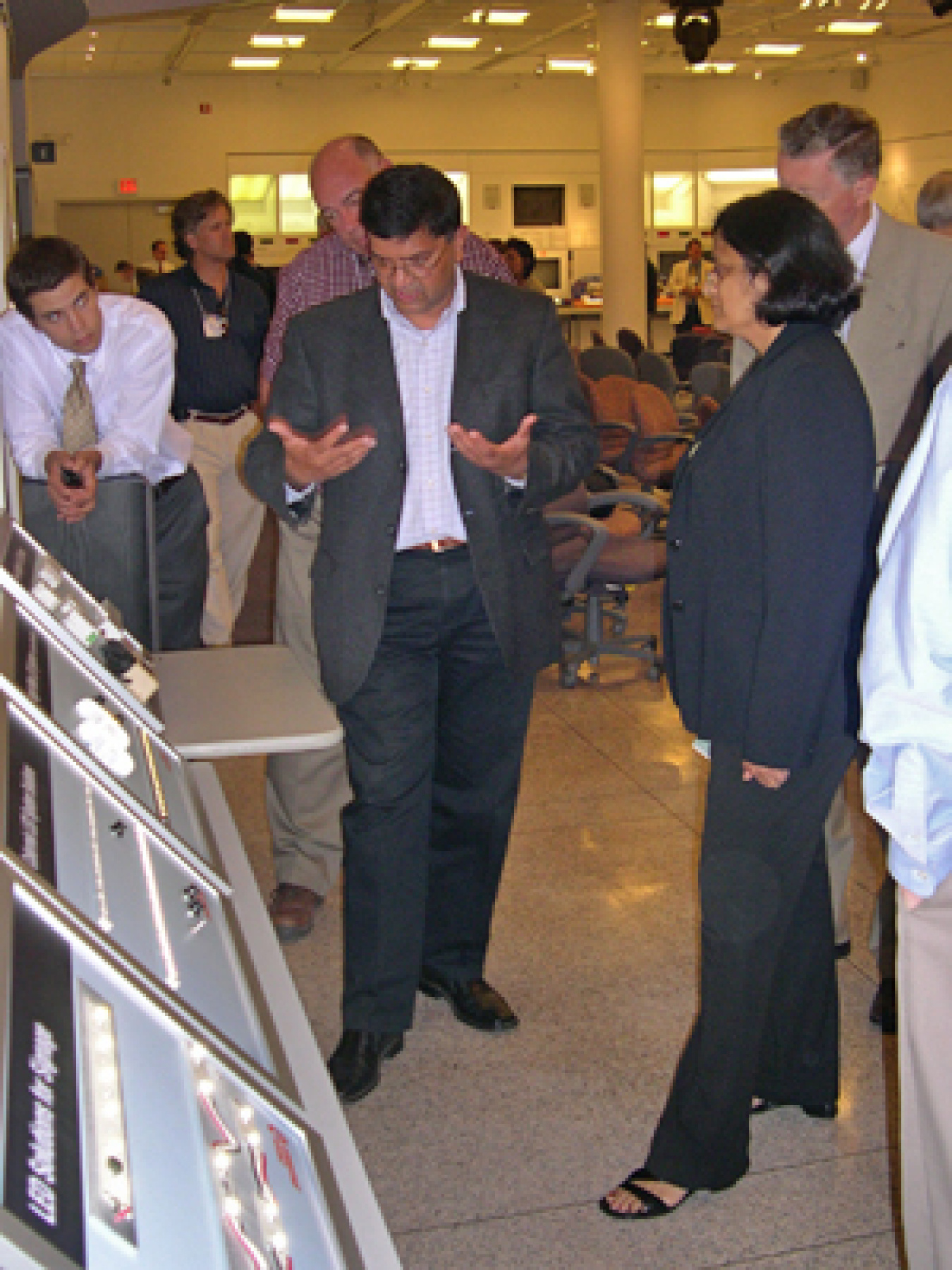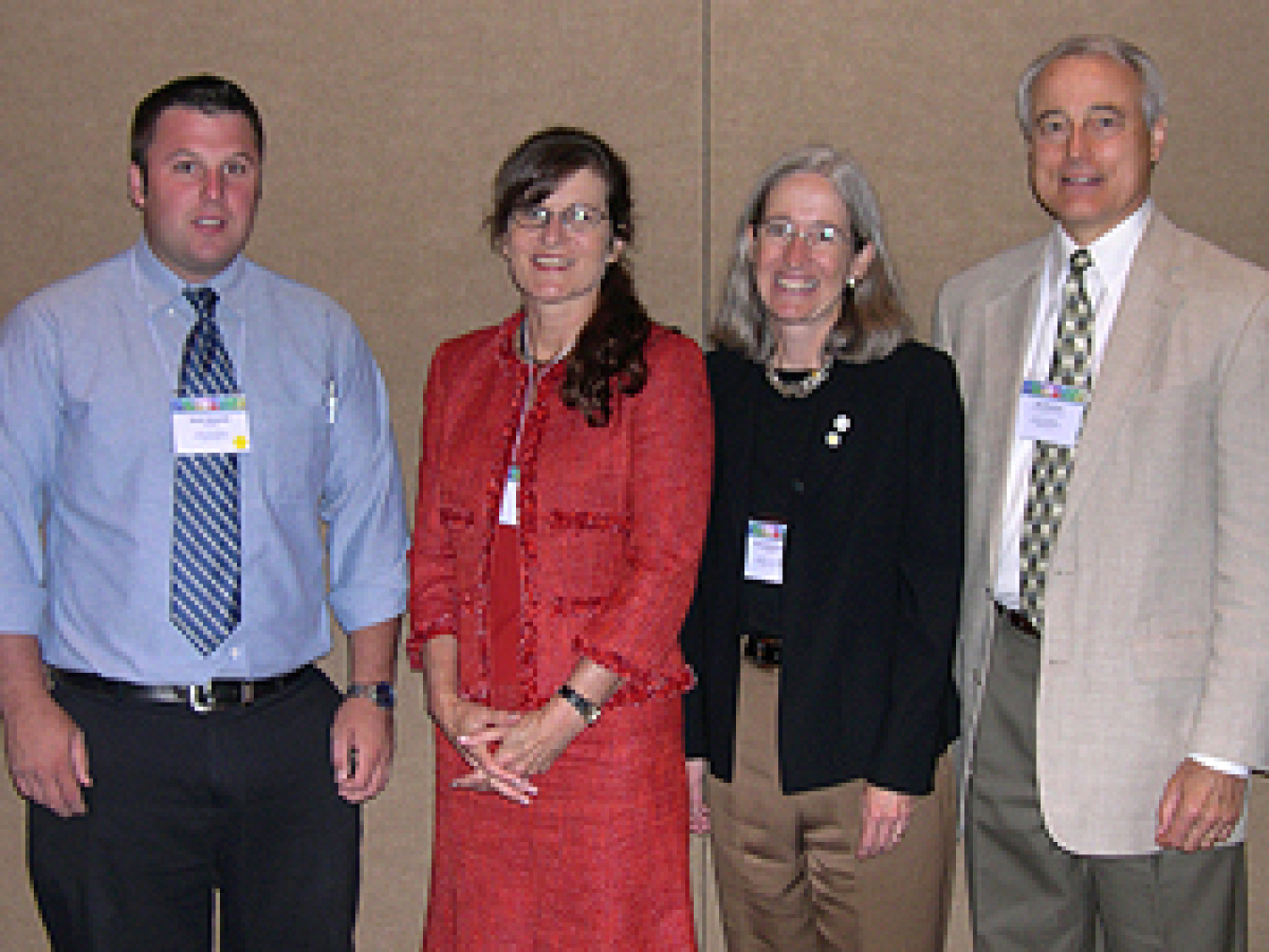Over 100 attendees gathered in Boston, MA to participate in the "Voices for SSL Efficiency" Solid-State Lighting Workshop on July 16-17, 2007. The workshop, hosted by DOE and Northeast Energy Efficiency Partnerships (NEEP), was the second DOE meeting to explore how Federal, State, and private-sector organizations can work together to guide market introduction of high-performance SSL products. The first workshop, hosted by DOE and Southern California Edison, was held in Pasadena in April 2007. In both workshops, a diverse gathering of participants – energy efficiency organizations, utilities, government, and industry – shared insights, ideas, and updates on the rapidly evolving SSL market.
SSL Essentials and Lessons Learned
DOE SSL Portfolio Manager James Brodrick kicked off the workshop by highlighting the pace of recent developments in SSL – significant efficacy breakthroughs, and commitments from early adopters like Wal-Mart and the California Home Builders to encourage widespread use of SSL. Brodrick reviewed DOE's national strategy to push SSL technology and the market to the highest efficiency and the highest lighting quality, emphasizing opportunities to partner and participate with DOE.
Kevin Dowling of Color Kinetics followed with a broad introduction to SSL technology, discussing the technology status, advantages and disadvantages, current applications, and future potential. "The first car with LED headlights is coming out in the next model year," Dowling said, as he described the evolving path of LED technology from indicator lights to general illumination. Market trends show rapid increases in efficiency, falling costs, and significant progress on technical issues. Dowling detailed the anatomy of an intelligent LED lighting solution, and described a number of current applications that take advantage of the inherent advantages of LEDs. For example, the decision by LAX airport officials to switch to LEDs for functional and architectural outdoor lighting has reduced their annual lighting maintenance costs from $1,000,000 to $20,000.

Kevin Dowling from Color Kinetics presented a broad overview of SSL technology, applications, advantages, and disadvantages.
Linda Sandahl of the Pacific Northwest National Laboratory (PNNL) then presented an overview of the DOE report Compact Fluorescent Lighting in America: Lessons Learned on the Way to Market (PDF 923 KB). The report provides an analysis of the market introduction of CFLs, identifying lessons learned that could be applied to the introduction of other lighting technologies such as SSL. "Early consumer experiences with fluorescent lamps and CFLs still define attitudes toward CFLs," Sandahl said. "Let's get it right with LEDs, and learn from our past."
Lessons learned from the past are incorporated into DOE's Five Year Commercialization Support Plan (PDF 805 KB). In his overview of the DOE SSL Portfolio, James Brodrick emphasized the Department's lab-to-market strategy, supporting SSL research, development, and market introduction activities. Brodrick cited DOE's partnerships with the Next Generation Lighting Industry Alliance and the Illuminating Engineering Society of North America, as well as over 150 market-side partners and 18 federal agency partners who are supporting deployment efforts. He then outlined key elements of DOE's Commercialization Support Plan, including buyer/user guidance, design competitions, technology demonstrations/procurements, product testing, and support for standards and test procedures.
Input on DOE Priorities
A core activity of the two-day workshop involved breakout sessions where participants explored case studies based on five hypothetical SSL products intended for various market applications. Leaders from each group reported their results and recommendations to all attendees at the end of the exercise. This input will help to determine if DOE commercialization plan elements adequately support the market introduction needs of new SSL products, and will serve to identify major stakeholders and the elements of the plan where their participation might be most valuable.

In breakout sessions, attendees identified key issues, barriers, information needs, and critical allies for hypothetical SSL products.
Mid-afternoon on Day 1, attendees traveled to OSRAM SYLVANIA's LIGHTPOINT® facility for a tour. The facility features interactive displays and training aids for live, classroom-based training for architects, lighting designers, distributors, utility representatives, and others. For example, three identical department store window displays enable users to compare lighting sources (incandescent, fluorescent, LED, sodium vapor) or vary the color temperature of white-light LEDs, and evaluate the effects on the eye's perception of color. An evening reception sponsored by OSRAM SYLVANIA offered attendees an opportunity for further discussion and networking.
Emerging Markets for SSL
Day 2 began with an analysis of the high-brightness LED market for lighting, presented by Vrinda Bhandarkar of Strategies Unlimited. The 2006 market was $205 million, and growing at around 37% each year. The market is projected to reach $1 billion in 2011. While the majority of today's applications use RGB, Bhandarkar's forecast indicates the use of white LEDs will increase to more than 60% of the market by 2011.
Next, three speakers from the New York State Energy Research and Development Authority (NYSERDA) offered an overview of NYSERDA's activities related to SSL. Marsha Walton detailed ten NYSERDA R&D projects related to SSL. Mark Michalski described various residential sector activities, currently centered LED holiday lighting. Priscilla Richards concluded with a recap of commercial/industrial efforts, highlighting the National Lighting Product Information Program (NLPIP) and its "Lighting Answers" newsletter, designed to educate the public about energy-efficient LED lighting solutions. NYSERDA is also looking at programs for new construction, existing buildings, and peak energy load management that can incorporate SSL.

Attendees learn about the interactive displays and training aids at OSRAM SYLVANIA's LIGHTPOINT facility.
DOE Commercialization Plan Elements
The PNNL team then provided a closer look at the DOE Commercialization Support Plan elements.
- Kelly Gordon offered an overview of the Lighting for Tomorrow design competition, which encourages and recognizes attractive, energy-efficient residential lighting fixtures.
- Bruce Kinzey described DOE's GATEWAY Demonstrations, designed to verify performance of selected SSL products in appropriate applications.
- Jeff McCullough discussed DOE's SSL Commercial Product Testing Program, which conducts independent testing of commercially-available SSL products for general illumination.
- Jeff McCullough then detailed the requirements of the draft ENERGY STAR® criteria for SSL products for general illumination.
- Eric Richman reported on DOE's activities to support the development of new standards and test procedures related to SSL.

Pictured, left to right: Mark Michalski, Marsha Walton, Priscilla Richards, and James Brodrick.
Brodrick concluded the two-day workshop with a reminder to participants that there are multiple opportunities to partner and participate with DOE, and shape the future of lighting in the U.S. For ongoing updates on DOE SSL activities and events, register for SSL UPDATES at http://www.eere.energy.gov/buildings/ssl/.
